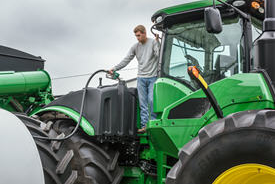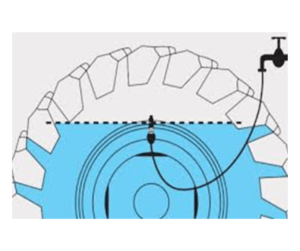PROPER BALLAST Fuel Savings
BKT USA, Inc.
Dave Paulk: Manager Field Technical Services
Ballast
The correct amount of wheel/tire ballast is important for a tractor because it helps to transfer the power from the tractor to the ground. With too little ballast, you are limited to the size of the implements/wagons you can pull. This can create too much tire slippage (tires spinning faster than the groundspeed of the tractor) and can cost you in fuel and time. 8% to 15% slippage is in the recommended range per industry standards.
Maxam Tire International
Greg W. Gilland: Business Development & Ag Segment Manager
| Best Practice | Suggested Activity | Expected Benefit or Result |
| Manage Tractor or Vehicle Weight | Modern tractors are outfitted with wheel or suitcase weights designed to adjust the axle loads to achieve the best possible setup based on the towed implement’s weight. If possible, avoid using water or liquid ballast in the tires as this creates additional weight and greater rolling resistance. | By ensuring the proper weight set up of suitcase or wheel weights for each type of tractor (2WD – MFWD – 4WD) operators can reduce tire slippage, reduce soil compaction, and reduce rolling resistance which will lower fuel consumption and improve overall machine efficiency delivering fuel savings. |
|
Managing Tire Slippage or Slip Rate
|
Most tractors have an onboard slip meter to measure the amount of tire slippage that impacts the utilization of the tractor and the resultant fuel consumption by managing the optimal slip rate. | Optimized tractor slip rates will reduce fuel consumption per the below guidelines:
· 2WD Tractors = from 10% up to 15% Slip Rate · MFWD Tractors = from 8% up to 12% Slip Rate · 4WD Tractors = from 8% up to 10% Slip Rate |
Michelin Ag
David Graden: Operational Market Manager – Agriculture
Proper Ballasting
Let’s take a look at proper ballasting. For a front wheel assist, we tend to lean towards a 40% front and 60% rear weight split. For 4×4, it’s around a 55 front/45 rear split. Proper ballasting not only improves your efficiency, but it also reduces stress on your machine’s transmission. Improper ballasting can create power hop in the field and road loping while driving down the road. Both can be dangerous and difficult to control. In the field, power hop is commonly caused by one axle rolling faster than the other and, in essence, the machine is fighting itself. When your machine is properly ballasted between front and rear, the tires, at proper air pressures, will be in sync.
For example: a MFWA machine fit with 480/80R50 rears and 420/85R34 fronts, improperly ballasted, may require 12 psi on the rear to carry the rear weight, and 28 psi on the front, to carry the front weight. As a general rule of thumb, this gap of more than 10 psi will create some major issues. These tires are matched up to fit within the tolerance of the machine’s transmission. With 28 psi on the front and only 12 psi on the rear, the rolling circumference of each tire is being pushed outside of the transmission’s tolerance and creating power hop. You may think, “I’ll just increase the air pressure of the rear to keep the tires within 10 psi.” Well, that will may likely solve your power hop issue, but you just increased your slip by reducing the size of your footprint on the rear. On the flip side, if your tractive capacity on the front is far greater than the tractive capacity on the rear, you didn’t fix anything, and power hop still exists. In either situation, a lack of efficiency consumes more fuel and costs you more.
Yokohama Off-Highway Tires America, Inc.
Blaine Cox: National Product Manager—Agriculture, Golf and Turf
If you are experiencing too much slip because your equipment is too light, ballast your tractor to optimize it. If the slip is the result of worn-out tread failing to provide enough traction, consider replacing your tires. Whatever the reason for it, slip is just another word for turning your wheels and burning fuel without getting work out of the process.
Precision Inflation Systems
Ken Brodbeck: VP of Technology
Like to Cut Your Fuel Bill by 5 to 10%? Changing Tire Pressures is the Answer!

What to Do?
- Check the tractor companies’ suggested ballast recommendations for your machine’s task. Planting will be lighter than heavy tillage in the fall. Ballast and adjust tire pressures accordingly.
- Weigh each axle so you can set the tire pressure per the tire manufacturer’s minimum pressure for the heaviest condition. Typically, this is the road transport.
- Your soil, tillage practices and hills may call for more ballast. How do you tell what is the right ballast?
- Wheel slip for radials should be in the 8 to 12% range for the best fuel efficiency. Sounds high right? Wrong! A lot of tractors are running consistently at 2 to 3% slip. The trouble is at 2% to 3% slip you are are burning extra fuel just to drag the tractor up and down hills while creating more soil compaction. Not Good.
- Lighten the tractor, especially for planting and possibly even grain cart work. If the slip goes up to 15% climbing one steep hill in the field, no problem and your fuel bill will thank you.
Trelleborg Wheel Systems
Chris Neidert: Marketing, Training and Development Manager – AG
Proper Ballast Set Up
Getting as much horsepower as possible transferred from the engine to the ground is the end target. Ballasting can help accomplish this by either adjusting existing weights or placing additional ballast (weight) either on the front or rear of the tractor. The goal isn’t to have 0% wheel slip – but to shoot for a preferred slip of between 8% and 15% for tractors.
- Having too high a slippage rate means spending more time than necessary in the field and wasting money on fuel as the tires are forced to spin more.
- Having too little slip means risk of overload on the tires, higher soil compaction, power loss, increased fuel consumption and lower productivity. Getting the proper ballast and tire inflation pressures can optimize traction, reduce compaction, increase the life of the tires, and increase productivity.
Capitalize on Engine Power
Regardless of the tractor horsepower that you are using goal is to capitalize on the engine power. Getting the tractor to be heavy enough to apply that power from the engine to the ground is paramount. This illustration shows that engine power turns into torque and assisted by the tires creating friction to the ground provide grip. The ultimate result is traction. This traction is what we are looking for to reduce spin and maximize fuel and reduce time.

WHEN do you need Ballasting?
Needed
- The weight/power ratio of the tractor is not enough, in particular when high traction is required.
- Tractor is unbalanced due to the use of additional equipment, and it is necessary to redistribute the axle weight. We must add weight to the opposite axle according to the implement to achieve proper axle weight ratios.
Not Needed
- For field preparation in low torque condition and on prepared field, to avoid an excessive soil compaction.
- High percentage of road travel
What TYPE of Ballasting is best?
LIQUID Ballast
It consists of the partially filling of the tires with water and/or antifreeze solutions. This is an economical method to add weight. Its use is only recommended in high torque applications, in particular on dry and tough soil, where you need to increase the weight/power ratio of the tractor. It is not advisable to use water ballasting for road transport. It is more difficult to handle the tractor, it increases the fuel consumption, increases braking time and causes rapid wear of the tires. Trelleborg does not recommend using liquid ballast. It stiffens the tire and reduces the footprint increasing compaction, reduces the ability of the tire to flex, can cause corrosion of the rim and creates additional inertia on the wheel when moving.

CAST IRON WHEEL FLANGE Ballast
Normally used to increase the weight/power ratio and improve traction. It is recommended for use in high torque applications on the field. Also, for road transport on HP tractors in order to avoid excessive wheel slipping at the start
Advantage: No Weight on the Axle. Disadvantage: Difficult to apply, Increased Cost

CASE WEIGHT Ballast
One option is cast iron plates or cast iron in one block fitted on the front part of the tractor: normally used to load the front axle and balance the weight distribution. It is recommended for tractors working in the field with a carried implement. Also, for road transport.
Advantages: Easy to Mount / Dismount.

Trelleborg recommends Case Weight ballasting!
WEIGHT SPLIT
Now, let’s determine what the tractor SHOULD weigh for its application. Below are guidelines:
- Use a calculation of 100 – 120 pounds per horsepower of the tractor. Example – a 200 horsepower tractor should weigh between 20,000 lbs. – 24,000 lbs.
MFWD (Mechanical Front Wheel Drive)
Distribution should be between 40-45% on the front axle and 55-60% on the rear axle. If the design of the implement creates a high load on the rear axle (reducing the load in the front axle), the ratio on front wheel assist tractor should be closer to 45-50% in the front and 50-55% in the rear
4WD
Distribution should be 50% on the front axle and 50% on the rear axle for 4WD
2WD
The front axle should have between 25-35% of the total load.
WEIGH PRECISELY
It is very important to measure this weight per axle with calibrated scales (individual per tire or per axle, like on a grain elevator scale or actual axle weighing scales). Your Trelleborg or Mitas sales representative can help.
- An incorrect weight distribution can create issues like “power hop” where the front axle is too “light” (losing traction) and the rear axle is overloaded creating excessive “grip.”
- When a customer has power hop issues, it’s a clear indication that the total tractor weight and/or weight distribution is not correct for the application. This issue can be fixed by correcting the ballasting without the need to change tire size or tire ratio. Air pressure can also be a factor.
Firestone Ag
Austin Fischer: Firestone Ag Field Engineer
Tactics to Reduce Fuel Costs
- Replace liquid ballast: Adding liquid ballast to tires increases the maximum amount of draft a tractor can exert, but it can reduce fuel efficiency in some situations when compared to using wheel weights. This is due to the stiffening effect of the liquid on the tire’s carcass, which causes it to deflect less and results in a smaller footprint. The smaller footprint translates to less lug surface area available to develop tractive force. Moving away from liquid ballast, and calcium chloride, for example, also removes the chance for corrosion of the tire rims, which would eventually necessitate tire replacement.
All information is provided in this blog solely to provoke thought. All deductions made from information on this site must be confirmed by Certified Ag Tire Dealer before use. Ag Tire Talk does not recommend anyone conduct tire service work with exception of Certified Ag Tire Dealer Professionals.

